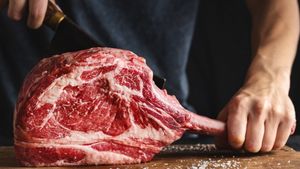JAKARTA - People see Jakarta as a plural city inhabited by various ethnic groups with all their dynamics. This has even been going on at the beginning of the formation of the city which was once known as Batavia, namely in the 17th century. The process of city formation and its problems such as slavery and prostitution is clearly described by a historian from the Netherlands, Hendrik E. Niemejer in his book Batavia: Colonial Society of the XVII Century (2012).
At the beginning of the formation of Batavia, Niemejer noted that the city was built from the ruins of Jayakarta's destruction in 1619. The conquest of Jayakarta was what caused the natives to leave Jayakarta, the Javanese were prohibited from living, and the surrounding forest was still inhabited by many wild animals. As a result, the Company, which wanted to build Batavia as a trading city, chose to bring in many slaves.
For the Dutch, bringing in slaves was the main option to gain profits from their colonies. Therefore slaves were imported from various regions both within and outside the country. Domestically, the Company brought in slaves from Maluku, Sulawesi, Bali and Nusa Tenggara. As for slaves from abroad, the Company brought slaves from India, Sri Lanka, to the Philippines.
In the end, the appearance of these slaves became part of the history of the civilization of the city of Batavia. Moreover, since the beginning of his tenure, the founder of Batavia, Governor-General of the VOC, Jan Pieterszoon Coen, then made ethnic Chinese the golden children of the economic turnaround in Batavia. This step made Batavia more diverse and full of dynamics.
It is these dynamics that make this book important. In addition, the owner of the book also discusses wild animal hunting, prostitution, slave resistance, to popular Dutch entertainment, namely gathering on the porch of the house. All of this is explained in detail. This is because Hendrik E. Niemeijer himself has been in a sea of VOC archives for years.
Wild animal huntingAt the beginning of the Dutch colonialism in Batavia, relaxing fun was not a citizen's habit. The reason was, whoever dared to step outside the Nieuwe Poort (New Gate), then cross the thicket forest area, they would have to bet their lives. Wild animals, such as bulls, tigers, rhinos, pigs, and crocodiles still roam a lot. In more detail, we have reviewed it in the article "Many Crocodiles in Ciliwung, Tiger Hunting in Batavia."
Hendrik called tigers a wild animal that often hung near the walls of the City of Batavia. According to him, during the first 50 years of the Dutch in the colony, the wild animal roaming became a serious threat to the Dutch. Therefore, the Dutch colonial government offered a reward to those who were able to catch and kill the "big cat".
"The daily diary of Kasteel Batavia says that once a month in the 1640s there must have been a tiger corpse on display in the Kasteel field. Because the threat of tigers had not yet subsided, the Head of the Judiciary, Joan Maetsuycker decided in 1644 to lead a large-scale hunting himself and to do that, 800 people were deployed consisting of 20 horsemen, 100 soldiers, 50 slaves and the rest were Dutch and native citizens. Chinese citizens, Banda and Javanese people, ”he said on page 80.
Prostitution in BataviaApart from that, the problem of prostitution was also discussed. At that time, this leisure business was growing rapidly at the beginning of the Dutch establishment in Batavia.
Many of those who work as sex workers are categorized as street prostitutes. There is also a disguised form of prostitution in the form of concubinage and mortgage. Due to a combination of concubinage and pawnshoping, the sex workers in Batavia encountered matchmakers or prostitutes, commonly known as "mamie".
Therefore, at the beginning of the Dutch in Batavia, it was the Europeans who opened many brothels. One of the famous brothels at that time was the hostel "de berebijt" (bear bite) owned by Hubert Yselstein. The popularity was obtained because Hubert's brothels were the most frequently recorded in the local court archives. We have also reviewed in full regarding prostitution in the article "Lonteku di Batavia".
"The inn is located some distance from the city walls, on Jalan Jaccatra (now Jalan Jakarta) and is not only famous as a place of prostitution, but also as a place for fighting, a fencing arena, as well as a hair-pulling direction," he wrote on page 189.
Slave resistanceBeing born a slave in Batavia is the saddest thing. Regardless of the employer, be it Dutch, Portuguese, Moorish or Chinese, these slaves were often beaten for trivial matters.
Slaves were usually tied up, whipped, and all kinds of things. Even if you have a good master, the problem is actually present in an environment that always looks down on slaves. It was also not uncommon for slaves to be beaten because they were in the lowest caste in Batavian society.
For that, many of them put up resistance. What's worst is that they decide to commit suicide. For example, when they had the opportunity to leave the house after being severely tortured by their employers, the slave immediately ran to the knife-selling shop, then stabbed himself in the chest.
“Another way of resistance that slaves often use is poisoning their masters. This method occurred quite frequently and regularly in Batavia and was indeed quite easy to do, ”writes on page 200.
Kongko on the porch of the houseMeanwhile, the unique habit of the Dutch in spending free time is to relax (kongko) on the porch or overhang of the house. For the Dutch, the porch of the house is like a guard post, the most fun.
Hanging out on the porch of the house is a good observation location for all the recent troubles in Batavia. However, those who have porches are only limited to the rich and very rich.
“Men delightfully smoke pipes, drink a sip of wine or a glass of wine from the Cape of Good Hope (South Africa), while women are busy pouring and drinking tea while tasting pastries; do not miss, betel and areca nut to freshen the mouth, "wrote Niemejer.
That is the summary that is present in this book. Even so, there are still many other interesting stories reviewed by the author. Such as the Muslim problem in Batavia, Catholicism in Batavia, the existence of Calvinists, the sugar business, the arak business, and so on.
The English, Chinese, Japanese, Arabic, and French versions are automatically generated by the AI. So there may still be inaccuracies in translating, please always see Indonesian as our main language. (system supported by DigitalSiber.id)








